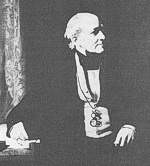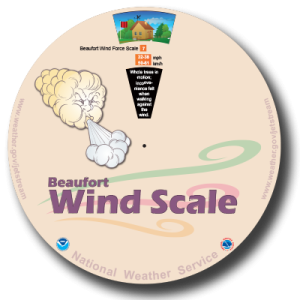In order to safely navigate the oceans, different measures, or scales, have been developed to describe wind and wave conditions.

The Beaufort Wind Force Scale
Rear-Admiral Sir Francis Beaufort was born in Ireland in 1774. He entered the Royal Navy at the age of 13 and was a midshipman aboard the Aquilon. By 1800, he had risen to the rank of Commander. In the summer of 1805, Beaufort was appointed to the command of the Woolwich, a 44-gun man-of-war.
In 1806, he wrote in his log book a wind force scale. The scale was simple and very similar to one that Alexander Dalrymple had written in a book in 1789. A year later, he added some criteria to the 0-12 scale that indicated how much of a ship's sails would be employed by a British man-of-war under each condition. It was not describing the speed of the wind, but rather the effect of the wind on the ship's sails.
Over the following years, he continued to use his scale in his logs. It was finally adopted in December 1838 by the British Admiralty for use in all Royal Navy logbooks. "However, as ship design changed and steam power became widespread, the scale had to be modified.
In 1912, the International Commission for Weather Telegraphy sought some agreement on velocity equivalents for the Beaufort scale. A uniform set of equivalents was accepted in 1926 and revised slightly in 1946, extending the scale to 17 values (the added five values further refining the hurricane-force winds). By 1955, wind velocities in knots replaced Beaufort numbers on weather maps.
Modern Beaufort Scale, including the observed land conditions:
| Beaufort Wind Force |
Wind Average |
Speed Range |
American term |
British term |
Sea State |
Sea Description |
Wave Height |
Land Description |
|---|---|---|---|---|---|---|---|---|
| 0 | 0 | <1 kt <1 mph <1 km/h |
Light | Calm | Calm | Sea like a mirror. | 0 | Smoke rises vertically. |
| 1 | 2 kt 2 mph 3 km/h |
1-3 kt 1-3 mph 1-5 km/h |
Light | Light air | Smooth | Ripples with the appearance of scales are formed, but without foam crests. | ¼ ft. 0.1 m |
Direction shown by smoke but not by wind vanes. |
| 2 | 5 kt 6 mph 9 km/h |
4-6 kt 4-7 mph 6-11 km/h |
Light | Light breeze | Smooth | Small wavelets, still short but more pronounced, crests have a glassy appearance and do not break. | ½-1 ft. 0.2 m |
Wind felt on face; leaves rustle; ordinary vane moved by wind. |
| 3 | 9 kt 10 mph 16 km/h |
7-10 kt 8-12 mph 12-19 km/h |
Gentle | Gentle breeze | Slight | Large wavelets. Crests begin to break. Foam of glassy appearance. | 2-3 ft. 0.6 m |
Leaves and small twigs in constant motion; wind extends light flag. |
| 4 | 13 kt 16 mph 24 km/h |
11-16 kt 13-18 mph 20-28 km/h |
Moderate | Moderate breeze | Moderate | Small waves, becoming longer. | 3½-5 ft. 1 m |
Raises dust and loose paper; small branches are moved. |
| 5 | 19 kt 22 mph 34 km/h |
17-21 kt 19-24 mph 29-38 km/h |
Fresh | Fresh breeze | Rough | Moderate waves, taking a more pronounced long form. (Chance of some spray). | 6-8 ft. 2 m |
Small trees in leaf begin to sway. |
| 6 | 24 kt 28 mph 44 km/h |
22-27 kt 25-31 mph 39-49 km/h |
Strong | Strong breeze | Very Rough | Large waves begin to form; the white foam crests are more extensive everywhere. (Probably some spray). | 9½-13 ft. 3 m |
Large branches in motion; umbrellas used with difficulty. |
| 7 | 30 kt 35 mph 56 km/h |
28-33 kt 32-38 mph 50-61 km/h |
Strong | Near gale | High | Sea heaps up and white foam from breaking waves begins to be blown in streaks along the direction of the wind. | 13½-19 ft. 4 m |
Whole trees in motion; inconvenience felt when walking against the wind. |
| 8 | 37 kt 43 mph 68 km/h |
34-40 kt 39-46 mph 62-74 km/h |
Gale | Gale | Very High | Moderately high waves of greater length; edges of crests begin to break into spondrift. The foam is blown in well-marked streaks along the direction of the wind. | 18-28 ft. 5.5 m |
Breaks twigs off trees; generally impedes progress |
| 9 | 44 kt 51 mph 82 km/h |
41-47 kt 47-54 mph 75-88 km/h |
Gale | Strong Gale | Very High | High waves. Dense streaks of foam along the direction of the wind. Crests of waves begin to topple, tumble and roll over. Spray may affect visibility. | 23-32 ft. 7 m |
Slight structural damage; chimney-pots and slates removed. |
| 10 | 52 kt 59 mph 96 km/h |
48-55 kt 55-63 mph 89-102 km/h |
Whole Gale | Storm | Phenomenal | Very high waves with long overhanging crests. The resulting foam in great patches is blown in dense white streaks along the direction of the wind. On the whole the surface of the sea takes a white appearance. Visibility affected. | 29-41 ft. 9 m |
Trees uprooted; considerable structural damage. |
| 11 | 60 kt 68 mph 110 km/h |
56-63 kt 64-72 mph 103-117 km/h |
Whole Gale | Violent Strom | Phenomenal | Exceptionally high waves. (Small and medium sized ships might be for a time lost to view behind the waves.) The sea is completely covered with long white patches of foam lying along the direction of the wind. Everywhere the edges of the wave crests are blown into froth. Visibility affected. | 39-46 ft. 11.5 m |
Widespread damage; very rarely experienced. |
| 12 | 68 kt 78 mph 124 km/h |
64-71 kt 72-82 mph 118-132 km/h |
Hurricane | n/a | n/a | The air is filled with foam and spray. Sea completely white with driving spray; visibility very seriously affected. | >52 ft. >14 m | Countryside is devastated. |
| 13 | 76 kt 88 mph 141 km/h |
72-80 kt 83-92 mph 133-148 km/h |
||||||
| 14 | 85 kt 98 mph 157 km/h |
81-89 kt 93-103 mph 149-165 km/h | ||||||
| 15 | 95 kt 109 mph 175 km/h |
90-99 kt 104-114 mph 166-183 km/h | ||||||
| 16 | 104 kt 120 mph 192 km/h |
100-108 kt 115-125 mph 184-200 km/h |
||||||
| 17 | n/a | >108 kt >125 mph >200 km/h |



